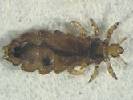
FRIDAY, March 14, 2014 (HealthDay News) — Most head lice found in North America now carry a gene mutation that makes them resistant to standard over-the-counter treatments, a new study cautions.
Head lice infestation is a major public-health issue, the researchers said, with roughly 10 percent of all American school-aged children missing school due to the intense itching and secondary infections that signal exposure.
The problem: Years of relentless exposure to a single treatment option has given rise to a surviving head lice population that is armed with what geneticists call “knockdown resistance,” in the form of the TI genetic mutation.
This gives most of today’s head lice an ability to withstand exposure to the main — and previously effective — ingredients found in most nonprescription head lice drugs: “pyrethroid” compounds such as permethrin.
“This isn’t really controversial,” said study co-author John Clark, a professor of environmental toxicology and chemistry at the University of Massachusetts, Amherst. “This is a problem we’ve been showing in development over a period of about 20 years. But our new work now shows that head lice are now almost 100 percent [knockdown resistant]. That means there’s an awful lot of resistant insects out there in the U.S. and elsewhere.”
Clark and his colleagues discussed their findings in the March issue of the Journal of Medical Entomology.
In the early 1990s, over-the-counter permethrin-based formulations entered widespread use, Clark said. Designed to kill lice by essentially short-circuiting their nervous system, such drugs became the standard of care.
But the seeds of permethrin’s future failure were planted decades earlier, in the immediate post-WWII period, he said, when much of the population was first exposed to the pesticide DDT in an effort to reign in body lice infestations.
Head lice got caught up in the process, giving rise to a surviving population that silently, but increasingly, began to carry the protective TI mutation decades before the introduction of permethrin products, according to the study.
With that in mind, investigators set out to assess the current resistance status of North American head lice by conducting a genetic analysis of lice samples collected from 32 mostly urban locations across the United States and Canada.
DNA sampling revealed that more than 88 percent of the lice found in both countries carried the specific TI mutation that is associated with the kind of nerve insensitivity that makes lice resistant to standard over-the-counter permethrin medications.
In the United States alone, the researchers pegged TI frequency in an average of roughly 84 percent of the lice population between 1999 and 2009. But a closer look at the final years of this timeframe revealed that the rate actually began to approach 100 percent of the lice population between 2007 and 2009.
Accordingly, Clark and his associates concluded that the need for new treatments for lice has reached a critical stage.
“Europe and South America actually stopped using these pyrethroid compounds years ago,” he said. “It’s not that these compounds aren’t in themselves good formulations. But the very last thing you want to do is treat a single pest population with one compound that has one mode of action for years and years — and that’s exactly what we did. The result is that these compounds are just not effective anymore.”
“But the good news is that over the last three years we have seen four or five new compounds entering the market,” said Clark, in reference to drugs that include the brands Ulesfia, Sklice and Natroba.
“They all have different kinds of compounds and mechanisms, and they’re all already commercially available,” he said. “This will lead to what’s called redundant killing, where if one compound doesn’t do the job, the other compound will. So there is a way forward.”
Dr. David Pariser, a professor of dermatology at Eastern Virginia Medical School, in Norfolk, agreed about the need to update treatment for head lice.
“I completely agree with this study’s assessment regarding resistance, and with the thinking about the new drugs that we now have available,” said Pariser, a former president of the American Academy of Dermatology. “I’ve had personal experience with one of them, as I was involved in the clinical trials, so I know they’re very effective.”
“More than that, they can actually be easier to use, as the older drugs would have to be applied repeatedly, whereas the new drugs are typically a one-time treatment,” he said.
“However, I would add one nuance,” Pariser continued. “While these new agents are great, they are prescription drugs, which means they are more costly. It may not be the actual insured consumer who will feel it if he’s only paying a co-pay for the new meds, but certainly it’s going to be a much bigger cost to the health care system as a whole.”
More information
For more about head lice, visit the U.S. Centers for Disease Control and Prevention.
Copyright © 2024 HealthDay. All rights reserved.

